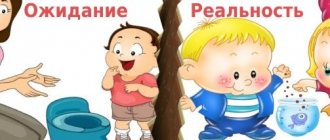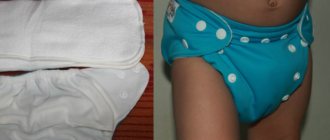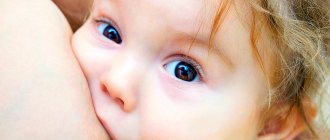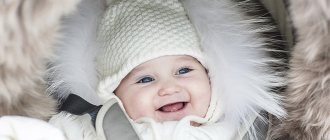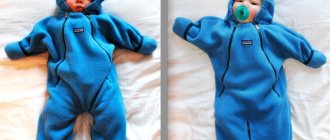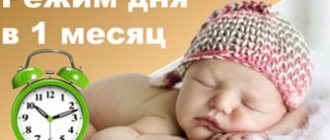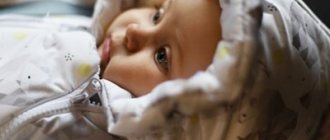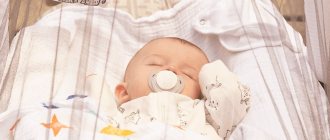How to dress a newborn for a walk
Proper preparation of an infant for a walk depends not only on the weather outside and time of year, but also on the region. The same temperature regime is perceived differently even by an adult. Sub-zero temperatures with high humidity are felt much more acutely than in the central regions of Russia with a drier climate. The correspondence table will tell you in detail how to dress a newborn on the street. However, it is important to take into account that wind speed and the degree of air humidity are not taken into account here; it is necessary to take into account the specifics of your climate.
| Air temperature | Suitable clothing |
| –20… –10° | Diaper, cotton slip, fleece slip, booties, overalls or fur warm envelope, light cotton cap, demi-season thin cap under the hood, scarf |
| – 10… – 5° | Diaper, cotton overalls, warm jacket, winter overalls or envelope with insulation, booties, demi-season thin hat under the hood, scarf |
| – 5… 0° | Diaper, warm overalls, winter overalls, demi-season hat under the hood, possibly a light scarf |
| 0… 5° | Diaper, cotton overalls, wool or velor overalls, demi-season overalls, knitted hat, light scarf |
| 5… 10° | Diaper, cotton slip, fleece slip, demi-season overalls with 40 g of insulation, knitted hat with hood |
| 10… 15° | Diaper, cotton overalls, demi-season envelope or overalls with 40 g of insulation |
| 15… 18° | In warm sunny weather, a diaper, a warm jumpsuit, a thin demi-season hat, in cloudy weather - a light slip and a demi-season overall, a hat |
| 18… 20° | A diaper, a bodysuit with short or long sleeves (or a light slip), a panama hat or a thin cap |
| More than 21° | Diaper, cotton bodysuit with short sleeves, Panama hat |
Special recommendations: Doctors advise not to wrap your child up too much, but rather take an extra blanket or fleece blanket with you. It is important to remember that the same temperature always feels different at different times of the year. How to dress a child outside at a temperature of 20° in autumn or summer is a significant difference, because the air can be heated differently.
Dressing the baby
Optimal temperature conditions are extremely important for a newborn. Often parents mistakenly believe that the baby needs to be wrapped up as tightly as possible so that he does not freeze, but this is completely wrong. The fact is that the crumbs quickly overheat, which in turn is much more dangerous than hypothermia.
So, what should a baby wear depending on the temperature outside:
- From -10 to -6 - a warm flannel blouse, a fabric slip underneath, knitted booties, thin and thick hats, and a winter suit or fur-lined envelope on top. Here it is assumed that at lower temperatures we do not go for a walk.
- From -5 to -1 - we leave everything the same as in the previous paragraph, only we remove the booties and warm blouse.
- From 0 to +4 - slip overalls, a thin cap and a demi-season hat, a winter suit and a scarf.
- From +5 to +9 - replace the warm sleepsuit with a lighter one and do not put on a cap, the rest is the same as in the previous paragraph.
- From +10 to +13 - a warm slip or romper with a blouse, a demi-season outer suit with a thin cap.
- From +14 to + 16 - the same scheme as indicated above, however, the outer overalls may already be made of artificial “plush” fur.
- From +17 to +20 - an insulated slip and a light cap will be enough.
- From +21 and above - a short-sleeved bodysuit with shorts or light pants; in extreme heat, remove the lower part. Be sure to cover your head with a Panama hat or scarf.
In cold weather, if you are an inexperienced parent and do not know how to dress your baby, follow this rule: put the same thing on your baby as you put on yourself, but add one more extra layer.
This is interesting: Vacationing on the beach with children - how to protect yourself from sunburn, overheating and dehydration
How to properly dress a child outside after one year
For parents of a one-year-old baby, the question of how to dress a child outside remains just as pressing. The table (1 year) will definitely undergo changes, because most babies have already taken their first steps and certainly want to explore the environment themselves.
| Air temperature | Suitable clothing |
| –20… –10° | Warm bodysuit with long sleeves, thick tights, warm jacket, warm socks, winter overalls (jacket-pants set), winter hat, scarf, mittens, warm boots |
| – 10… – 5° | Warm bodysuit with long sleeves, thick tights, warm jacket, warm socks, winter overalls (jacket-pants set), winter hat, scarf, mittens, warm boots |
| – 5… 0° | Warm bodysuit with long sleeves, thick warm tights, warm jacket, warm socks, winter overalls (jacket-pants set), winter hat, scarf, mittens, warm boots |
| 0… 5° | Warm bodysuit with long sleeves, light tights, winter overalls (jacket-pants set), winter hat, scarf, mittens, warm boots |
| 5… 10° | In cold windy weather - a light body with long sleeves, light tights, winter overalls, demi-season boots, a knitted hat; in sunny weather, the winter version of outerwear can be replaced with a demi-season version |
| 10… 15° | A warm bodysuit with long sleeves, light tights, demi-season pants and a jacket, a light knitted hat, boots, and in cool weather - warm socks |
| 15… 18° | Light cotton bodysuit with long sleeves, warm pants and jacket, socks, sandals, hat |
| 18… 20° | The boy has a long-sleeved shirt/T-shirt, light trousers or shorts, socks, sandals, a hat The girl has a long-sleeved T-shirt under a sundress or light trousers/breeches, a dress under light tights, sandals, a Panama hat. |
| More than 21° | T-shirt with short sleeves, shorts, sandals, hat; The girl has the same set + sundress or light dress |
Special recommendations: Very often doctors complain that parents at this age do not know how to dress their child outside in the spring. However, the psychological fear of removing the baby’s hat at temperatures above 15° is inappropriate if the weather is sunny and windless. It is recommended to be guided by your own feelings, because the table provides only conditional correspondences.
Tips and table on how to dress your child according to the weather in winter
The duration of walks and, accordingly, the amount of clothing a child wears will depend on the weather in winter: with infants in cold and dry weather you can walk for up to 20 - 30 minutes, with older children - 1.3 - 2 hours, provided that the clothes are warm and windy and there is no heavy snowfall. When going out, there are a few things to consider:
- For babies who cannot walk yet, you need to take a warm blanket.
- It is better to choose thermal underwear made from natural fabrics for any age: it is hypoallergenic, retains heat well and prevents excessive sweating. It should be worn on a naked body, and not on tights and jumpers.
- It is not necessary to wear a hood over the hat if the temperature is not lower than -8 - -10˚C, otherwise the child will become hot.
- You should not tie the scarf too tightly, especially if it is not very cold outside (otherwise more blood will flow to your head, and your hands and feet will freeze).
- You can understand that a child is dressed very lightly and is freezing by touching his neck, not his hands. If the skin behind the collar is cool, you need to dress warmer.
- Mittens are a must have in your winter wardrobe. It would be better if they were water-repellent.
- For newborns in strollers, you need to buy an insulated envelope, a blanket and overalls with closed legs.
| Temperature | Age | Matching wardrobe |
| From -10˚C to -6˚C (at temperatures below -10˚C it is not recommended to walk with infants) | Infants up to 6 months | Insulated vest and overalls, hat and booties, gloves. There should be a blanket in the stroller |
| 6-12 months | Flange inner slip, booties, winter overalls, jacket, scarf and hat with a hood, gloves | |
| 1-2 years | Bodysuit with sleeves, jacket, tights and warm socks, hat, scarf and gloves. | |
| 3 years | Golf, winter tights and warm socks, jacket, overalls, winter boots and mittens | |
| 5-7 years | Tights, insulated knitted trousers (better than bolognese trousers), boots, puffers or coats, hat, mittens and scarf | |
| -5˚C to -1˚C | Infants | Keep the same wardrobe, but you can remove the booties and vest |
| 6-12 months | Leave everything mentioned above except booties and a warm jacket | |
| Children from 1 to 3 years old | You don’t have to wear socks or insulated sweatshirts | |
| 5-7 years | You can remove warm socks. It is better to replace bologna pants with warm leggings |
See also:
How to teach a child to go potty and at what age to start (at 1-2.5 years)?


